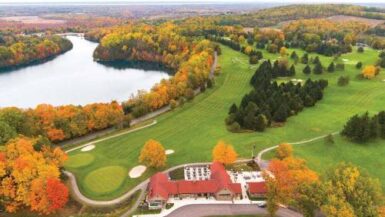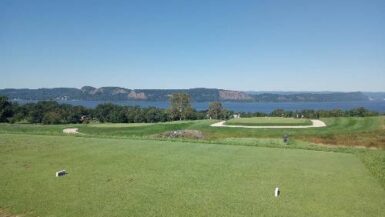You’ll remember The Knoll Club won a Jazzy for Best Public Course this year. The stats and overview are here.
Here’s a deeper analysis of some of the great holes designed by Charles Banks, many of which are also featured at such classics as National Golf Links of America and Yale:
Lets get something straight from the start; The Knoll will eat you alive if you are careless, frustrated, absent-minded, sloppy, overly aggressive, greedy or egotistical. The greens are relentless; one careless putt or chip, anytime, anywhere and you’ll end up further away than when you started. Two putts are by no means a given and one putts and downright endangered on these hurly-burly greens. Fiendishly clever in their intricacy, they are a Mensa puzzle waiting to be solved and take as much feverish concentration and patience to score well. The mantra of the golf course is “look easy, play hard.”
Â
           The Knoll, and indeed all great golf courses, built their foundations upon the greatest force of human nature – temptation. Each hole is a setup, a trap created with simplicity and acute insight into a player’s ego and ability or inability to know their limitations. Each can result in a self-inflicted wound waiting to happen for those who don’t play within their skill level. The Knoll’s hallmark is cloak and dagger peril, you know the blow will fall, but where? The minute you lose focus, that’s where!
Â
           The course starts with a Road Hole, modeled loosely after its famous ancestor at the Old Course at St. Andrews. No there’s no “Old Course Hotel” over which to hit (or pick an “O!”), and the Road bunker is not a round pit, but the narrow sliver of a green is filled with internal contours. Two mounds running lengthwise through the center of the green result in tough-to-read double and even triple breaks. If the player is off line with his approach, chip or putts even slightly, the result is likely bogey or worse.
Â
           For those that need soothing after the excitement of the first hole, good luck, because the second green is a double plateau with fierce internal swales. With the green divided into three distinct sections and with other bumps in the putting surface, it’s one of the most impressive and difficult greens a player will ever see. “I guard the original design of these greens with my life” Bahto explains gruffly and with a look that would stop a charging buffalo were it foolish enough to try to walk across a putting surface. Looking at the gorgeous example of an ancient design concept, it’s easy to see why.
Â
           The Knoll showcases four great par-3 designs that were favorites of Macdonald, Raynor and Banks: a Redan, a Short, a Biarritz and an Eden. The Redan appears at the third hole. A deep, diagonal bunker guards the green, its floor set ten to twelve feet below the putting surface.Â
Â
The par-4 fourth hole provides a fascinating case study into how golf courses evolve over time. “On some holes, the only thing we had to do to put the architectural strategy back in was to move some tees back” Bahto explains. “But on four, the greenside “Lion’s Mouth” bunker was almost a center-line bunker, but now it’s well to the left of the line of play.” The fourth fairway was much wider decades ago, but over time, mowing patterns eliminated almost forty yards of playing corridor along the left side. Now, the area is just rough, but Bahto will be restoring that portion of the fairway, bringing the bunker back into the hole much more prominently. By restoring that part of the fairway, the Hog’s Back ridge will once again deflect approach shots, sending them ricocheting in either direction.Â
Â
After a long par-5 which really contains three small greens within one, (in keeping with the concept of making the putting surface small on a par-5), the “Short” appears at the par-3 sixth hole. Typical of other famous Short holes, the green is completely surrounded by a series of bunkers which sit several feet below the putting surface. Small internal depressions will deflect irons shots and make getting close to the hole difficult, defending par admirably even though the hole is pint-sized. A “Bottle hole” at the par-4 eighth and a “Punchbowl” at the par-4 ninth are the highlights that round out the front side.Â
Â
The back nine is equally exciting and features as many boldly contoured greens, beefy par-4s and intricate golfing puzzles as the front. “The highlight is the Biarritz; it’s the primary reason why you’re here” he says pointedly as we step on the tee. You can see a smile spread across is face as he looks down the fairway of this monster of a par-3.
Â
Almost all great courses in Ireland and the U.K have one par-3 that requires a par-3. The trend came abroad during the golden age as well. From the blue tee, this fine example of the concept plays a stiff 247 yards, frequently requiring a driver. A deep swale guards the front of the green and two deep bunkers flank either side to catch errant drives.
Â
Some Biarritzes feature the swale as part of the green, most notably Yale Golf Club and Mid-Ocean Club in Bermuda. Other architects such as Brian Silva find the swale such an admirable defense itself, he frequently builds them with no bunkers. “There’s no need sometimes, the contours are severe enough a defense” he said, speaking of his Biarritz at the eleventh hole at Boston’s Black Rock. Here, however, the payer sees the classic example of the design feature, rather than the modern twist. Both work equally well.
Â
As if the swale, the length and the bunker weren’t fearsome enough, two deflector mounds on either side kick balls sideways. Finally, the green contains an interior contour in the shape of a horseshoe, another old-school feature usually found on the Short hole also, but is a prominent feature on this monster of a Biarritz. “That hole throws the kitchen sink, the couch, the stove, the moonshine still in the backyard and the piano at you” quipped one irreverent wag of a local player who begged to remain nameless. Commenting on the horseshoe in the green, he remarked, “Whoops! There goes the dresser! But don’t tell Bahto I said that; he’ll shoot me and bury me in a hole somewhere! Seriously though, it’s one of the best holes I’ve ever seen anywhere and is as brilliant and difficult as the Biarritz at Yale” he finishes admiringly. “It’s really great that public players can come here and see all these great features. Macdonald, Raynor and Banks courses are an endangered species for public course players. What Bahto’s doing here, restoring this classic so the masses can enjoy it, is nothing short of marvelous” he ends admiringly.
Â
I’d often wondered if Banks, Raynor or Macdonald ever reversed their holes or made some “two-shot” versions of holes that were normally par-3s and the answer came as we made our way through the finishing holes.  The par-4 fourteenth features a reverse road hole green with bold interior contours, including swales that those with vivid imaginations might think resembled the letter E, with two depressions in the negative space. After a terrific Eden hole at the par-3 seventeenth, the eighteen is a reverse Redan. Again, the fairway had moved many yards to the right, taking some centerline bunkers into newly grown rough. “I noticed my approach after a good drive was always in the 185-190 yard range. “One day it hit me, this is a two-shot redan” Bahto says energetically. At 450 yards, severely uphill and with the gorgeous clubhouse as a backdrop, eighteen at The Knoll has always been regarded as one of the best finishing holes in the tri-state area.
Â
CHIP SHOTS AND TAP-INS
Â
           “The city was desolate…It lay before us like shattered bark in the midst of the ocean, her masts gone, her name effaced, her crew perished and none to tell whence she came, to whom she belonged, how long on her voyage or what caused her destruction-her lost people to be traced only by some fancied resemblance in the construction of the vessel…” So wrote explorer John Lloyd Stephens in Incidents of Travel in Central America, Chiapas and Yucatan when describing his discovering the lost Mayan city of Copan deep in the Honduran jungle with artist and architect Frederick Catherwood. After being lost for centuries, these intrepid and enterprising adventurers trusted their courage, fortitude, instincts, pluck and luck and revealed to the world the wonders of a formerly lost ancient treasure.
Â
           But their good fortune continued, indeed multiplied. The land upon which the ruined city lay was owned by Don Jose Maria Acevado, the patron of the nearby village. In return for curing his wife’s acute rheumatism, Acevado sold the ruins to Stephens and Catherwood for $50, liberally estimated at a paltry $2,200 in today’s economy. Copan is revered as one of the seven wonders of the ancient Western Hemisphere along with Chichen Itza, Palenque, Tikal, Machu Picchu, Teotihuacan and Mesa Verde.
Â
In the world of golf, and in particular public golf, it’s no reach to compare the renaissance and restoration of The Knoll Club to the finding and reclaiming of a lost city. Like Stephens and Catherwood, Bahto had to reach back to hallowed antiquity, teach himself a previously unknown discipline and trust his instincts in determining that it was indeed Banks, the disciple of Raynor who built The Knoll many decades before. Like Copan, the greatness of The Knoll lay hidden in the Cimmerian fog of history, her true pedigree seemingly lost as nearly no one was left who knew her secrets. Time and the elements were hastening the course to oblivion until Bahto focused public attention on the splendors of the course and began his long restoration. Not only did he reclaim the golf course’s strategy, he sparked a lively and intellectual discourse on both an architect relatively unknown to the casual fan, but also brought a discussion of the finer, but important points of golf course architecture to the fore. The public has responded, proving that since golfers are by nature a high-brow and intellectually stimulated group, if tyou teach them, they will learn and come around to a different way of thinking about golf design.
Â
For example, the Biarritz, once roundly vilified as the worst hole on the golf course, now is almost the unanimous favorite of the members due to Bahto’s educating the members. Once he explained both its venerable nineteenth-century European pedigree and design concepts, the members, ardent golfers that they are, changed their position. They were grateful and proud to become part of the rich heritage of Charles Banks.Â
Â
The strength of the golf course is the par-4s. In fact, after Bahto is done he will have added over 500 yards to the course and every par-4 except seven will exceed 400 yards from the back tees. With this diamond in the rough polished to a high shine, public golfers in the greater New York area now have a solid rejoinder to fabled Bethpage. If there is a drawback, as of this writing, they do not allow walking, a terrible oversight that must be corrected. After all, the founding members of the club deliberately chose Raynor and Banks with the instructions that the course be easily walkable and such walkability is inextricably tied to the historical fabric, indeed raison d’etre of the golf course.





I’d heard of the Knoll before but I didn’t realize it had such an amazing pedigree. Thanks for pointing this place out, it has been moved up on my list of courses to seek out.